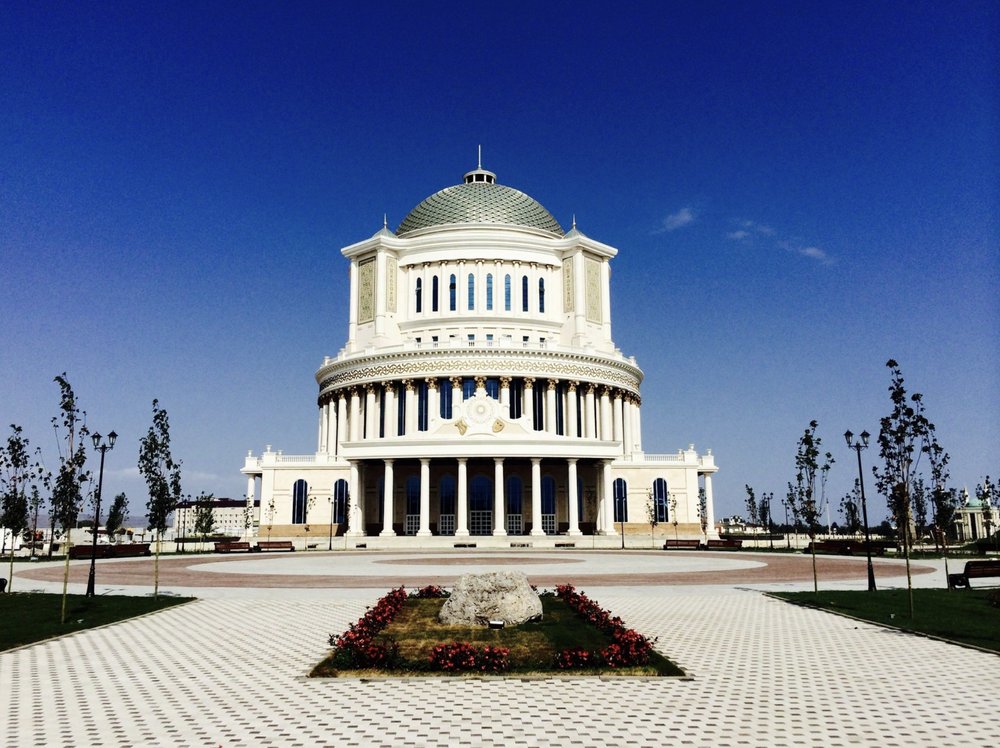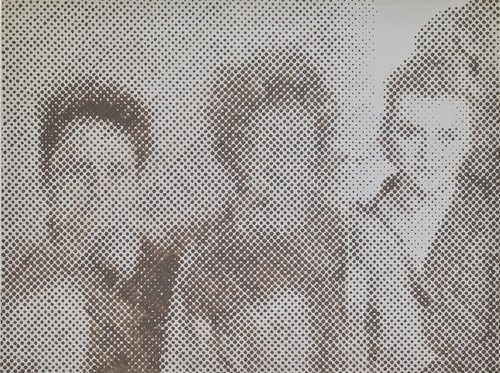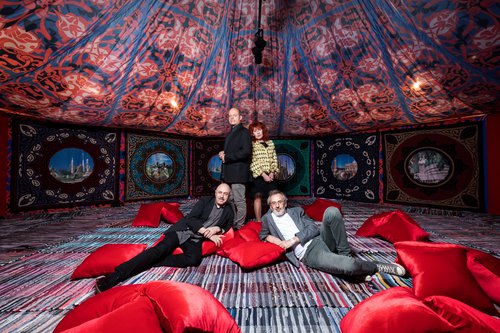Goisum Against Interpretation

Aslan Goisum. Prospect Pobedy, 2014. Video Still. Courtesy of Kromus + Zink, Berlin
Aslan Goisum is known by the international art community for poignant works which reflect on the tragic history of his native Chechnya and he has just opened his first institutional solo show in Germany where he is living today. Titled ‘Suspect,’ it is a psychological and suggestive self-portrait of the maturing artist.
Located in a repurposed brewery in Berlin’s Neuköln district, KINDL Centre for Contemporary Art first showed Aslan Goisum back in 2020 in a group exhibition called ‘The Invented History’. While still referencing his earlier oeuvre, it was around then that Goisum started to create art devoid of any clear and rational explanations.
The artist was born in Grozny in 1991 the year before the USSR broke down (then in Chechen-Ingush Autonomous Republic, now the Chechen Republic, Russia). As a child he lived through the so-called Chechen wars which resulted in a humanitarian catastrophe with civilians of all stripes dying and fleeing the hostilities in their tens of thousands. As a young artist, working in a variety of media, he initially focused on the themes of remembering, of collective survival and the preservation of culture and dignity, which fit into an anti-colonial discourse. His early work from 2011 ‘Prosthetics’ is an object made from wedges of books sewn together, a scarred and dysfunctional volume.
Two years later was ‘Gate’ a real metal gate shot through with bullets salvaged from post-war Grozny. Placed in a half-dark room with a torch shining at it, the object casts a deep shadow onto the wall beyond, resembling a night sky with bizarre white constellations.
Public recognition came to the artist early in his career while still a student. Dropping his russified family name Gaisumov in favour of the original Goisum in the 2010s he took part in numerous exhibitions in parallel with his studies at Moscow’s Institute for Contemporary Art (IPSI), then as a postgraduate in Ghent’s HISK and finally in Amsterdam at the Rijksakademie van Beeldende Kunsten where he graduated in 2019. His fluency within the global art language and his own unique experiences have shaped a conceptual turn of mind, which together with the aesthetically appealing imagery of his photography and videos have evolved into a highly distinctive personal style.
‘Prospekt Pobedy’ (Victory Alley) of 2014 is a video installation which combines views of Grozny from Soviet television screens with the post-war walls of the same city and it won the coveted Ukrainian Victor Pinchuk Foundation’s Future Generation Art Prize that same year. This work was followed by ‘Volga’, a video of a beaten-up, once luxury namesake Soviet car with a crowd of twenty-one people all slowly attempting to climb into it together, reminiscent of countless exoduses of families in war-torn places. He also produced ‘Numbers’, an installation consisting of dozens of black metal plaques with street names in Russian, that he salvaged in the deserted streets of his former hometown.
This group of works dealing with first-hand experiences of war would not be complete without ‘Memories of War’ (2016). A framed page torn out of a book titled ‘War Memories’ with the original text blackened out leaving only one word: “War”.
2016 was a turning point for Goisum where he began to dig deeper into the layers of metropoly-colony ties between Soviet Chechnya and Russia dating back to the 18th century and earlier. During World War II, in 1944, nearly half a million Chechens and their neighbors, Ingushs, were deported by force to Kazakhstan and Kyrgyzstan in the south-east of the USSR, on the suspicion that long-standing opponents of Russia might be collaborating with the advancing German forces. This deportation was performed as a military operation with very little time given for people to gather up their belongings and tens of thousands of people died. Goisum addresses this tragedy in two works. ‘People of No Consequence’ (2016) shows an empty hall slowly filling up with elderly people all of whom were deported, survived and returned after 1957. ‘Keicheyuhea’ (2017) is about Zayanu Khasueva, Goisum’s maternal grandmother, who speaks about her former life in a village in the mountains before she and her relatives were taken away and which does not exist today.
In 2017 Goisum took part in the First Garage Triennial of Russian contemporary art in Moscow. As a participant he was invited to recommend an artist for the 2nd Triennial (2020–2021), and he chose Petr Zakharovich Zakharov-Chechenets (1816–1846) introducing another layer of memory and history. Having only lived for thirty years Zakharov was a small child when saved by the famous Russian general Ermolov from the ruins of a Chechen village that had been destroyed under his orders. The future painter was raised in the general’s family as though he was their son. The work on show in the Garage was a portrait of Ermolov by the ethnically Chechen Zakharov, raising complex questions around attitudes of power within a family or state. Technically a work by a different artist, together with the caption, this was in the end a spectacular conceptual gesture by Goisum.
Anders Kreuger, who together with Julija Fomina organized the group exhibition ‘Blood and Soil: Dark Arts for Dark Times’ at CAC Vilnius in 2019 wrote in his essay: “It should also come as no surprise that some of Goisum’s most important references are artistic articulations of genocidal atrocities: Claude Lanzmann’s film ‘Shoah’ (1985), Alfredo Jaar’s photography-based ‘Rwanda Project’ (1994–98) and Jonathan Littell’s novel ‘Les Bienveillantes’ (2006).” It may be seen as a serendipity of sorts that currently at KINDL, where Goisum is exhibited in the stylish grey halls called Maschcinenhaus M1, Jaar’s installation is running downstairs in the unrenovated space dubbed Kesselhaus.
That Vilnius exhibition, in addition to some of the works already mentioned, featured ‘Skythische Reise’ (Scythian Journey) from 2019, a moody video titled after a poem by W.G. Sebald (1944–2001), who lived half of his tragically short life in England, and studied in depth the question of forced or voluntary migration. His recurrent motif was a Jewish child transported from the Nazi Germany to the UK just before World War II. There is a monument in Friedrichstrasse train station in Berlin with such children, some marching bravely towards their new life, some rejected and left behind only to be later sent to concentration camps. This all resembles Sebald’s Dr. Henry Selwyn or Max Ferber (who is based on the figure of the painter Frank Auerbach) from ‘Die Ausgewanderten’ (The Emigrants), and Austerlitz from the namesake novel. They eventually all become relatively successful, but earlier experiences banished into the furthest recesses of their minds is what ultimately cripples them mentally.
The flight of the refugee, immigration and exodus are common tropes for numerous 20th century German writers, including Thomas Mann with his ‘Joseph and his Brothers’ (the third part of the tetralogy was written in France and the fourth in the USA), and Hermann Hesse, who experienced life as an immigrant even before World War I. He did not accept the war doctrine and was harassed for much of his life.
Back to the ‘Skythische Reise’: it is a video about some obscure people in the woods, who make a stop at dusk during what seems to be an endless journey and they light fires. While they are doing this darkness sets in and later it is only the fire that is visible. This video feels like a watershed between early Goisum and his current self.
Having moved from his home town Grozny to Berlin early in 2022, he has mounted several exhibitions there including ‘Our Memories Are Quite Similar but Pickled Alive in a Poison Which Accompanies Objects Too as a Part of This Emptiness’ at P/////AKT in Amsterdam in 2022, when he first showed empty black rectangular fences, resembling grave enclosures; ‘The Sum of Silence’ the following year at Emalin in London when he first displayed ‘Spear’, book stacks wrapped in pink paper, with chunks being taken out as though attacked with a monstrous, sharp weapon. Then last year was ‘Prism’ in Lunds Konsthall in Sweden where Goisum showed the first version of a video installation of the same name. A slow-motion depiction of a naked male body shown on three screens. In contrast to his earlier work, in these exhibitions he has edged towards a more poetic and multi-faceted view of the world.
At the current show at KINDL in Berlin, Goisum is intentionally evasive when asked about meanings or interpretations. It is not by chance that the title ‘Suspect’ is a word that can point to many different concepts. Curator Kathrin Becker writes that “Aslan Goisum’s works reverberate through a space of anticipation: foreseeable actions that may not take place, expectations that may be frustrated. Speech is one such possible disappointment, memory is another. Divesting from any form of curiosity that is easily satisfied, ‘Suspect’ articulates a search for objects, images, and situations that create meaning beyond the necessity of narratives.”
The exhibition largely consists of photographic works, and ‘Prism’ (2025) an analogue 16mm film loop with a geometrical figure created through a ray of light from the projector to a rectangular screen, a corresponding crackle filling the video projection room. There is also his 2025 ‘Door’, large black metal gates open between the adjoining spaces, and a neon sign ‘Psychoanalyse’ (Psychoanalysis) a recent work by the artist placed above one of the gates.
There are no simple readings in this show and we can only try to analyze it through Goisum’s previous work. There is his 2018 series of colour landscape photography ‘Untitled’ made in Chechnya, where in the images there are traces of people who had once lived there – foundations of houses and the remains of walls in the same shade of brown as the earth. In a recent work from this year, ‘Snow’ you can only guess at Caucasus as the location, there is no certainty and there are other photographs which were clearly shot elsewhere like South Korea in his work ‘Portrait’. Perhaps there is a sense that the artist is carrying around with him his interest in power relationships as seems evident in recent works ‘Square #1’, ‘Circle #1’ and ‘Move #1’. These photographs look like psychological landscapes hiding intentionally obscure references.
Standing back for a moment and surveying the exhibition as a whole, the double ‘Door’ pieces serve as a reminder or echo of his earlier ‘Gate’, yet on a different plain they act as dividing lines between the body in ‘Prism’ and neon ‘Psychoanalysis’, for now wide open but impossible to pass when closed. The places and people and situations in his photography as content of the inner life of a person.























